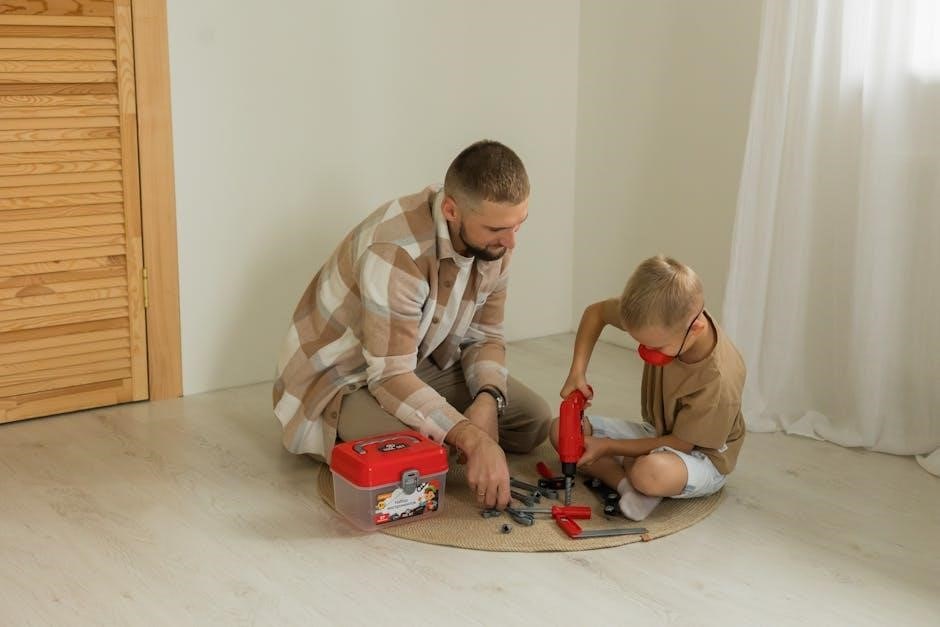A proper putter length ensures optimal posture, alignment, and stroke mechanics, impacting performance and comfort. This guide helps golfers find their ideal fit for consistent results.
Overview of Putter Length Importance
Putter length plays a crucial role in a golfer’s performance, directly influencing posture, alignment, and stroke mechanics. A well-fitted putter ensures a consistent and comfortable setup, reducing the risk of back strain and misalignment. Proper length also affects how the eyes align with the ball, impacting accuracy and confidence. While standard lengths range from 32 to 36 inches, customization is key to optimizing individual swing dynamics and personal comfort. Understanding the importance of putter length is the first step toward improving consistency and control on the greens.
Objective of the Guide
This guide aims to provide golfers with a comprehensive understanding of putter length and its impact on their game. By exploring the importance of proper fit, the guide helps players optimize their posture, alignment, and stroke mechanics. It offers insights into how to choose the right putter length based on height, stance, and personal preference. The ultimate goal is to enhance consistency, accuracy, and comfort, ensuring golfers can perform at their best. Whether you’re a novice or an experienced player, this guide serves as a valuable resource for improving your putting game.

Why Putter Length Matters
Putter length significantly impacts posture, alignment, and stroke mechanics, affecting accuracy and comfort. Proper fit enhances performance, reduces injury risk, and ensures a consistent, confident putting stroke.
Impact on Posture and Alignment
Putter length directly influences a golfer’s posture and alignment. A putter that is too short may cause a hunched or crouched stance, while one that is too long can lead to an upright posture. Proper length ensures a neutral spine angle and balanced setup, reducing strain and promoting consistency. Alignment is also affected, as incorrect posture can disrupt the ability to aim accurately. A well-fitted putter length allows for a comfortable stance, maintaining proper eye position relative to the ball and enhancing overall putting accuracy and control.
Effect on Stroke Mechanics
Putter length significantly impacts stroke mechanics, as it affects how the club moves during the putting motion. A properly fitted putter length ensures a consistent swing path and face angle, promoting a smoother stroke. If the putter is too long, it can cause the hands to move away from the body, potentially leading to an open face at impact. Conversely, a putter that is too short may result in a more upright stance, altering the swing plane and potentially causing the face to close. Proper length allows for a balanced, repeatable motion, enhancing accuracy and consistency in the stroke.
Importance of Proper Fit
A properly fitted putter length is crucial for optimal performance and comfort. It ensures correct posture, alignment, and stroke mechanics, reducing physical strain and enhancing consistency. A well-fitted putter allows for a natural swing path, promoting accuracy and control. Proper fit also prevents compensations in technique, such as twisting or manipulating the clubface, which can lead to inconsistent results. By matching the putter length to individual needs, golfers can achieve a more efficient and repeatable putting motion, ultimately improving overall performance on the greens.
Factors Influencing Putter Length
Putter length is influenced by posture, stance, eye line, ball position, stroke style, and personal comfort, ensuring a consistent and efficient putting motion for each golfer.

Posture and Stance
Posture and stance significantly influence putter length, as they determine how the body aligns with the club. A putter that is too short may force a hunched posture, while one that is too long can lead to an upright stance. Proper posture, with a slight bend from the hips, promotes consistency and reduces injury risk. The putter length should allow the eyes to align vertically above the ball, ensuring accurate targeting. A well-fitted putter length supports a balanced stance, enabling a smooth, controlled stroke and improved overall performance on the greens.
Eye Line and Ball Position

The position of your eyes relative to the ball significantly impacts alignment and accuracy. A properly fitted putter length ensures your eyes align vertically above the ball, enhancing your ability to see the target line clearly. If the putter is too short, your eyes may be inside the ball, while a putter that’s too long can position them outside. To test this, drop a ball from the bridge of your nose; where it lands relative to the putter blade indicates whether your eyes are aligned correctly. Proper alignment improves consistency and reduces misalignment, leading to more accurate putts.
Stroke Style and Technique
Your stroke style and technique play a crucial role in determining the ideal putter length. Golfers with a straight-backstroke style may benefit from a slightly longer putter, while those with an arc stroke often prefer a shorter length. The putter’s length should complement your natural swing path, ensuring a smooth, consistent motion. Proper fit allows for better control and reduces the risk of twisting or manipulating the club during the stroke. Custom fitting considers these factors to optimize performance and alignment, helping you achieve a more repeatable and accurate putting stroke.
Personal Preference and Comfort
Personal preference and comfort significantly influence putter length selection. While standard lengths provide a starting point, individual factors like posture, stance, and stroke style often require customization. Some golfers prefer a longer putter for a more upright posture, while others opt for a shorter length to maintain a consistent stroke. Comfort during the swing is crucial, as it directly impacts performance and confidence. Custom fitting ensures the putter aligns with your unique needs, enhancing both accuracy and overall putting experience. Prioritizing comfort helps golfers maintain focus and consistency on the greens.
Standard Putter Lengths
Standard putter lengths typically range from 32 to 36 inches, with 34 inches being the most common. Men’s standard lengths are around 33-35 inches, while women’s are 33-34 inches.
Men’s Standard Lengths
Men’s standard putter lengths typically range from 33 to 35 inches, with 34 inches being the most common. This range is designed to accommodate the average height and posture of male golfers, ensuring proper alignment and stroke mechanics. The 33-35 inch range allows for a comfortable stance and consistent ball positioning, which are critical for accurate putting. While these lengths are standard, customization based on individual needs is always recommended for optimal performance.
Women’s Standard Lengths
Women’s standard putter lengths generally range from 33 to 34 inches, slightly shorter than men’s standards. This range is designed to accommodate the average height and posture of female golfers, promoting proper alignment and stroke mechanics. The shorter length helps maintain a comfortable stance and consistent ball positioning, which are essential for accurate putting. While these lengths are standard, individual customization is recommended to ensure the best fit for personal comfort and performance on the green.

Height-Based Putter Length Guide
Using your height as a reference, a height-based putter length guide helps determine the ideal fit for consistent strokes and proper alignment on the greens.
General Guidelines
Putter length generally ranges from 32 to 36 inches, with 34 inches being the most common. Height is a key starting point, but posture, eye alignment, and stroke mechanics also play a role. Proper fit ensures a comfortable stance and consistent ball striking. While standard lengths are a good reference, personal fitting is recommended for optimal performance. Adjustments may be needed based on individual swing characteristics and preferences. A well-fitted putter enhances accuracy, control, and overall putting confidence.
Measurements for Custom Fit
Custom fitting involves precise measurements to determine the ideal putter length. Key factors include height, posture, and eye position relative to the ball. Measure wrist-to-floor length to estimate baseline length. Stand in your putting stance and ensure eyes are slightly above the ball. A professional fitter may use specialized tools or software to refine the fit. Proper measurements ensure optimal alignment, posture, and stroke consistency; This personalized approach helps golfers achieve better accuracy and control on the greens, tailored to their unique physical characteristics and swing style.

Custom Fitting Options
Custom fitting offers tailored solutions, including adjustable putter models and professional assessments. Experts use specialized tools to optimize length, ensuring a perfect match for your stance and stroke.

Adjustable Putter Models
Adjustable putter models offer flexibility, allowing golfers to customize length to suit their posture and stroke. Brands like Ping feature putters with adjustable dials, enabling length changes between 32-36 inches. These models cater to various putting styles, providing a tailored fit without the need for multiple clubs. Adjustable putters are ideal for golfers experimenting with different techniques or addressing posture-related issues. While they offer convenience, professional fitting is still recommended to ensure optimal performance and comfort.
Professional Fitting Process
A professional fitting process involves expert analysis to determine the ideal putter length for a golfer. Fitters assess posture, eye alignment, and stroke mechanics to recommend the best fit. They use tools like lie boards and dynamic fitting systems to measure how the putter interacts with the golfer’s stance. This personalized approach ensures optimal performance and comfort. Many professionals also consider the golfer’s injury history, such as back issues, to suggest modifications like lengthening the putter. The goal is to enhance alignment, consistency, and overall putting efficiency.
Measuring for Correct Putter Length
Measuring putter length involves assessing posture, eye alignment, and stroke mechanics. Using height-based guidelines or DIY tools ensures a proper fit for consistent and comfortable performance.
DIY Measurement Techniques
Golfers can measure putter length at home by assessing posture and eye alignment. Stand with your putter, bend slightly at the hips, and ensure eyes are over the ball. A ball dropped from the bridge of your nose should land near the putter’s center. If it falls behind, the putter may be too long; if forward, too short. This simple test helps determine optimal length for consistent strokes and proper alignment, ensuring a comfortable and effective putting setup without professional tools.

Using a Fitting Chart
A fitting chart is a valuable tool to determine the ideal putter length based on height and posture. By aligning your height with the chart’s guidelines, you can identify the recommended length for optimal performance. Most charts suggest lengths ranging from 32 to 36 inches, with 34 inches being the most common. Ensure the chart accounts for your stance and eye alignment. Combining this with a DIY measurement test ensures accuracy. This method provides a reliable starting point for golfers seeking a properly fitted putter to enhance their putting consistency and overall game performance.

Impact of Putter Length on Performance
Proper putter length enhances posture, alignment, and stroke consistency, directly improving accuracy and overall performance. Incorrect lengths can lead to discomfort and inconsistent results on the green.
Alignment and Accuracy
Proper putter length ensures your eyes align directly above the ball, promoting a consistent stroke path. A putter that’s too short or long can lead to misalignment, affecting accuracy. Incorrect length often results in pushed or pulled shots due to improper posture or stroke mechanics. To check alignment, drop a ball from the bridge of your nose; it should land just above the putter face. This simple test helps determine if your putter length supports proper eye positioning for better alignment and more accurate putts.
Posture and Comfort
Proper putter length is crucial for maintaining a comfortable and efficient posture. A putter that’s too short forces a hunched stance, while one that’s too long may lead to standing too upright. Both extremes can cause discomfort and strain, particularly for golfers with back issues. Correct length allows for a slight hip bend and neutral spine, reducing fatigue and preventing long-term injury. Tiger Woods, for instance, lengthened his putter to alleviate back pressure, highlighting how customization can enhance comfort and performance during practice and play.
Stroke Mechanics and Consistency
Putter length significantly impacts stroke mechanics and consistency. A properly fitted putter ensures a smooth, controlled motion, while incorrect length disrupts rhythm and accuracy. Too short or too long can cause the wrists to hinge or the hands to manipulate the clubhead excessively. This leads to inconsistent ball striking and direction. Proper length allows for a pendulum-like stroke, maintaining a consistent roll and alignment. Adjusting putter length can help golfers develop a more repeatable motion, essential for improving overall putting performance and confidence on the greens.
Specialized Putter Lengths
Specialized putters, like belly and long putters, cater to unique needs. Belly putters (40-45 inches) promote stability, while long putters (48+ inches) aid posture. They suit specific techniques and preferences.
Belly Putter Lengths
Belly putters typically range from 40 to 45 inches, designed to be anchored against the body for stability. This style reduces wrist movement, promoting a smoother stroke. The added length allows for better control and consistency, especially for golfers with back issues or those seeking a more stable putting method. Belly putters are a popular choice for players looking to improve accuracy and reduce fatigue during long rounds. They offer a unique solution for golfers who struggle with traditional putter lengths and stroke mechanics.
Long Putter Lengths
Long putters, typically ranging from 46 to 52 inches, are designed for golfers seeking maximum stability and consistency. These putters are often used by players with back issues or those preferring an upright posture. The extended length allows for a smoother stroke with minimal wrist movement, enhancing accuracy. Some professionals have adopted long putters to achieve a more consistent roll. While they may require adjustment, long putters offer a unique solution for golfers looking to refine their putting technique and improve overall performance on the greens.

Current Trends in Putter Length
Current trends emphasize adjustable putter lengths, allowing customization for optimal fit. Innovations like Ping’s adjustable models and pros like Tiger Woods influencing longer lengths for comfort and performance.
Adjustable Length Technology
Adjustable length technology in putters allows golfers to customize their club to fit their posture, stance, and stroke. Brands like Ping offer models with adjustable dials, enabling length changes between 32 and 36 inches. This innovation provides flexibility for golfers to experiment and find their ideal setup without reshafting. Adjustable putters are gaining popularity as they accommodate different techniques and body types, ensuring consistent mechanics and improved performance. This trend reflects the growing emphasis on personalization in golf equipment.
Professional Golfers’ Preferences
Professional golfers often customize their putter lengths for optimal performance. Tiger Woods, for instance, lengthened his putter to reduce back strain, while Matt Kuchar added inches to his shaft for better alignment. These adjustments highlight the importance of fit and comfort. Pros frequently work with fitters to ensure their putters match their stance, posture, and stroke style. Such personalized tweaks can significantly impact consistency and confidence on the greens, showcasing the value of tailored equipment in elite golf.
Case Studies and Examples
Professional golfers like Tiger Woods and Matt Kuchar have successfully adjusted their putter lengths to improve posture, alignment, and stroke mechanics, demonstrating the benefits of customization.
Tiger Woods’ Putter Adjustment
Tiger Woods famously adjusted his putter length to alleviate back discomfort, especially after his spine surgery. He slightly lengthened his iconic Scotty Cameron putter, allowing him to stand more upright and reduce strain on his back. This adjustment enabled him to practice longer and maintain consistency in his stroke. Woods’ decision highlights how customizing putter length can address physical limitations and enhance performance. His example encourages golfers, particularly those with back issues, to consider similar adjustments, ideally with guidance from a PGA Professional to ensure proper fit and technique.
Other Professional Examples
Matt Kuchar notably adjusted his putter length, adding inches to his shaft for better alignment and comfort. Similarly, Ping introduced adjustable putters, allowing golfers to customize lengths between 32-36 inches. These examples show how professionals adapt equipment to their needs, emphasizing the importance of proper fit. Such adjustments not only enhance performance but also prevent discomfort, illustrating the growing trend toward customization in golf. These real-world applications highlight the significance of tailoring putter length to individual preferences and techniques for optimal results on the green.
Maintenance and Adjustment Tips
Regularly assess your putter length to maintain proper posture and comfort. Adjustments can prevent injury and improve consistency, especially for golfers with back issues or changing swing mechanics.
When to Adjust Putter Length
Adjust your putter length if you experience posture issues, discomfort, or inconsistent strokes. Changes in swing mechanics, injury recovery, or adopting a new stance may also require adjustments. For example, Tiger Woods lengthened his putter to alleviate back strain, while Matt Kuchar extended his shaft for better alignment. Regularly assess your fit to ensure optimal performance and comfort. Consulting a professional can help determine the ideal adjustments for your specific needs and technique.
Reshafting and Refitting
Reshafting and refitting are essential for optimizing putter performance. These processes allow for precise adjustments to length, lie, and loft, ensuring the club fits your stance and stroke. Reshafting involves replacing the shaft to achieve the desired length, while refitting fine-tunes the putter’s specifications. This is particularly beneficial for golfers who experience inconsistent strokes or discomfort. Adjustable putters, like Ping’s Sigma 2 models, offer flexibility, enabling customization without permanent modifications. Regular refitting ensures long-term consistency and comfort, adapting to changes in your technique or physical condition.
Troubleshooting Common Issues
Identify issues like misalignment or inconsistent strokes due to improper putter length. Adjustments in length or lie can resolve posture-related problems and improve accuracy. Seek professional fitting if needed.
Too Short or Too Long
A putter that’s too short forces a crouched posture, potentially causing back strain and inconsistent strokes. Conversely, a putter that’s too long may lead to standing too upright, disrupting alignment and ball position. Both scenarios can result in poor contact and misaligned putts. If you notice persistent issues with posture or stroke consistency, consider adjusting your putter length. For example, Tiger Woods lengthened his putter to alleviate back discomfort. Professional fitting or DIY measurements can help determine the ideal length for your stance and technique. Always test adjustments on the course to ensure improvement.
Fixing Posture-Related Problems
Posture issues often stem from a misfit putter length. A putter that’s too short can cause a hunched stance, leading to discomfort and inconsistent strokes. Conversely, a putter that’s too long might result in standing too upright, affecting alignment. Adjusting the putter length to match your height and stance can resolve these issues. For instance, Tiger Woods lengthened his putter to reduce back strain, enabling a more upright posture. Proper fitting ensures a comfortable stance, promoting consistent mechanics and better performance on the greens.
Proper putter length is crucial for optimal performance and comfort. This guide provides tools to find your ideal fit, ensuring consistent strokes and improved confidence on the greens.
Final Thoughts
Choosing the right putter length is essential for consistency and comfort. Proper fit ensures optimal posture, alignment, and stroke mechanics, directly impacting performance. While standard lengths provide a starting point, personalization is key. Factors like height, stance, and technique influence the ideal length. Adjustable models and professional fittings offer tailored solutions. Experimenting with different lengths can reveal what works best for your game. Prioritizing fit and comfort leads to better accuracy, confidence, and overall enjoyment on the greens. Don’t overlook this critical detail in your pursuit of a better putting game.
Encouragement to Get Fitted
Investing time in finding the perfect putter length is a game-changer for your short game. A professional fitting ensures your putter matches your unique posture, stance, and stroke style, leading to improved accuracy and consistency. Even small adjustments can make a significant difference in your performance and comfort. Don’t hesitate to explore custom options or adjustable models to tailor your putter to your needs. Taking this step can elevate your confidence and enjoyment on the greens, helping you achieve your full potential as a golfer.
